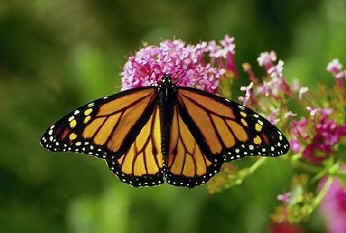Pam Van Pelt
Adam's County Master Gardener Program
 Nearly everyone recognizes the bright orange and black of the regal Monarch butterfly. Their beautiful colors always reminded me of stained glass windows. Unlike many butterflies, it’s easy to tell the difference between the male and female Monarch. The males have a black spot on each hind wing and their black webbing is narrower than the females.
Nearly everyone recognizes the bright orange and black of the regal Monarch butterfly. Their beautiful colors always reminded me of stained glass windows. Unlike many butterflies, it’s easy to tell the difference between the male and female Monarch. The males have a black spot on each hind wing and their black webbing is narrower than the females.
The Monarch butterflies we see each spring awaken from their hibernation in the Transvolcanic Mountains in Mexico and begin their journey northward. There are four generations of Monarchs each year that complete the migration cycle. Amazingly, no Monarch that leaves the mountains in Mexico will return to this small hibernation area.
Their cycle begins as they leave their wintering home. This first generation finds a mate and begins its northward journey. Along the way, the female lays eggs beginning in March and April. The eggs hatch in four days and then become caterpillars. After feeding continuously for two weeks, the caterpillar forms a chrysalis and in approximately ten
days it becomes the adult butterfly. As an adult, it finds a mate and starts the cycle of egg laying again. A female Monarch can lay between 100 and 1000 eggs in her lifetime.
 After two to six weeks, the adult dies and the next generation begins. This continues through the second and third generations (May through August). The fourth generation adults (September & October) do not breed. They will leave from Canada and the northeastern US to make their 2000 mile trip back to central Mexico where they will not breed until
the following spring. Their lifespan is six to eight months; however, much of that time is spent hibernating.
After two to six weeks, the adult dies and the next generation begins. This continues through the second and third generations (May through August). The fourth generation adults (September & October) do not breed. They will leave from Canada and the northeastern US to make their 2000 mile trip back to central Mexico where they will not breed until
the following spring. Their lifespan is six to eight months; however, much of that time is spent hibernating.
Like all butterflies, there are four stages of their life: the egg, larvae (caterpillar), pupa (chrysalis) and the butterfly. Monarchs will only lay their eggs on milkweed, so if you have no milkweed in your garden, you will only see the adults sipping nectar and passing on to the next garden that has their host plant. Once the eggs hatch, the
caterpillars eat only milkweed. Milkweed sap contains toxins that build up in the caterpillar and remain in the adult butterfly. These toxins make the caterpillar and the adult butterfly poisonous to many predators.
During the past several years, the Monarch’s population has decreased substantially. Before they begin their journey north, they cluster in oyamel trees in the Transvolcanic Mountains just west of Mexico City. Millions of hibernating Monarchs in such a very small area make them very susceptible to loss of habitat. Oyamel trees are valuable for
lumber, and the local people depend upon them for income. In addition to the loss of the trees themselves, the cutting of the trees makes a hole in the forest canopy allowing snow and rain to enter and causing the hibernating Monarchs to freeze to death. There has also been considerable damage to the oyamel trees from weather-related events such as mudslides, drought and
high winds. In 2010, it was reported that Monarchs suffered as much as a 50% decline in their population due to weather-related causes in their hibernation area. Much work is being done in Mexico to prevent further deforestation and loss of habitat.
In addition to the important work in Mexico, what can we do to help increase Monarch Butterfly numbers? First, stop using pesticides. Pesticides are deadly to butterflies. Always try to use a more environmentally friendly solution to pest problems.
Second, plant milkweed, their host plant. There are many varieties of milkweed to choose from. The butterfly weed is a very pretty plant and will reseed itself to cover a large area. Plant in an area in full sun and let it spread. It is a perennial that grows 12-14" and blooms in summer. Once established, it is very drought tolerant and attracts
butterflies and bees of all kinds. The Red Milkweed Beetle also enjoys munching on the butterfly weed. Like the Monarch, they are reddish orange and black and are toxic to birds. The coloration is a sign to potential predators that they are poisonous and should be avoided.
The third thing you can do is to plant lots of flowers that contain nectar for the adult butterflies. Some of their favorites are Indian Hemp, Swamp Milkweed, Common Milkweed, Asters, Joe-Pye Weed, Dame's Rocket, golden rods, Lilac, Red Clover, Tall Ironweed, Azaleas, butterfly bush, sumac, viburnum, alyssum, candytuft, cosmos, impatiens,
marigolds, bee balm, verbena, coneflower, yarrow, zinnia, phlox, daisies, and catmint. These three things will help the struggling Monarch and allow our future generations to enjoy this magnificent butterfly.
Read other articles on birds, wildlife & beneficial insects
Read other articles by Pam Van Pelt